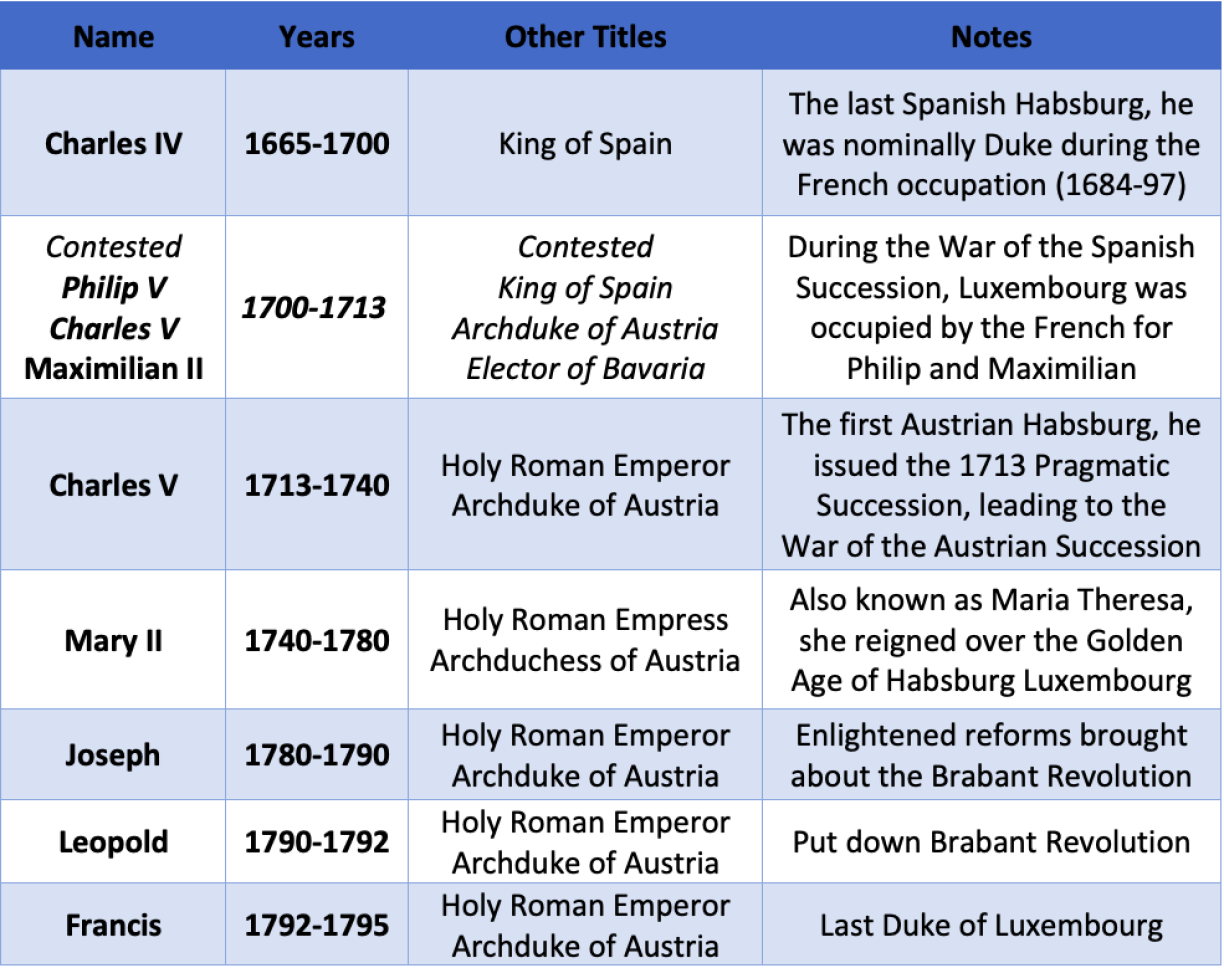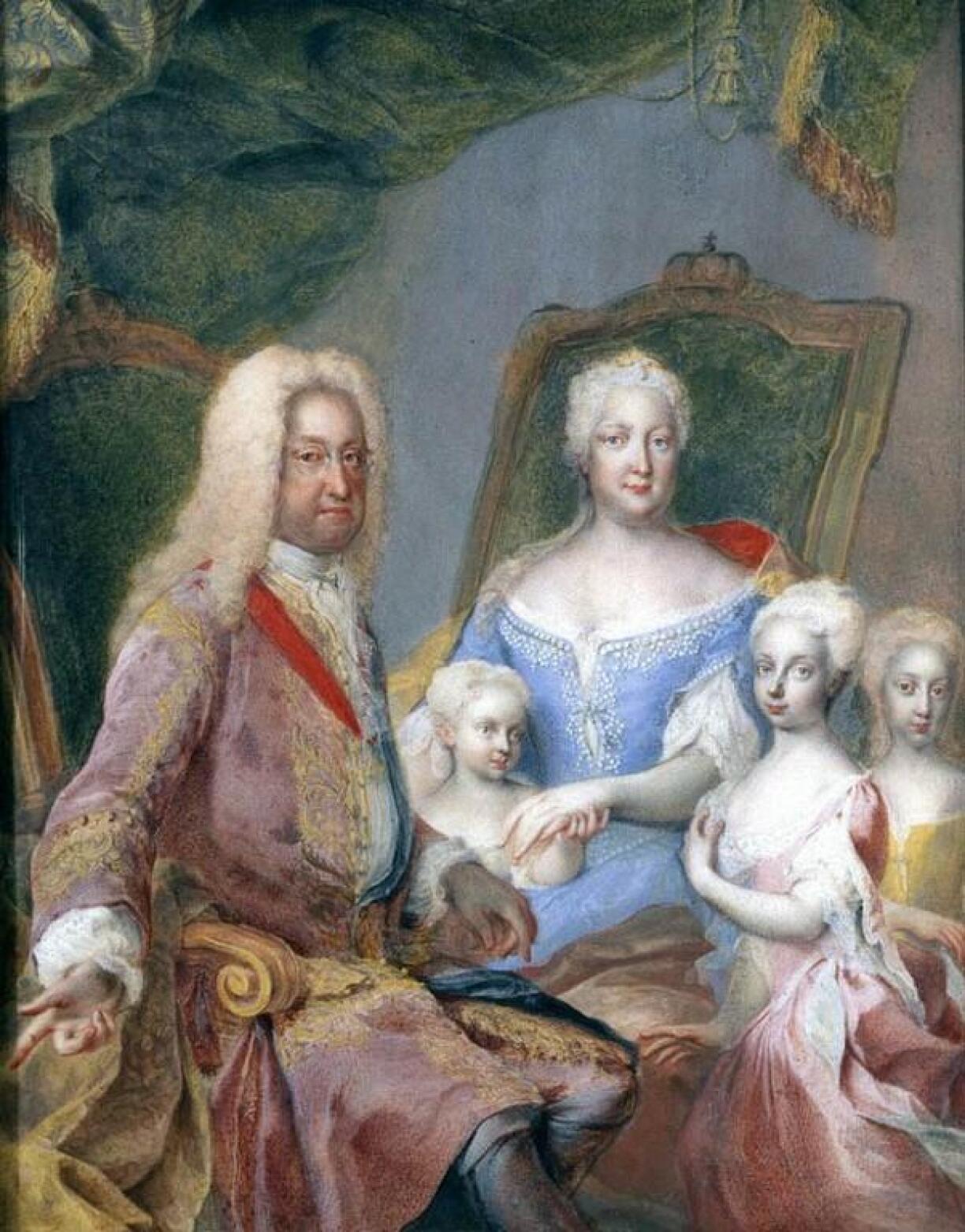
Following two centuries of Spanish Habsburg rule, Luxembourg was left in ruins by a series of bloody wars, culminating in the French occupation from 1684 to 1697
Europe experienced continuous conflict throughout much of the 18th century. However, Luxembourg arguably enjoyed a Golden Age under the notably competent leadership of five Austrian Habsburgs. Let’s explore the contributions of these Austrian Dukes and Duchesses of Luxembourg.
You can do so by listening to our Luxembourg History Podcast right below – including what the Spanish branch of the Habsburg family was up to – or by continuing to read.
Here at the Luxembourg History Podcast, we never want to upset you... but welcome to the penultimate episode of our first series.
The death of the last Spanish Habsburg, Charles II, in 1700 left a power vacuum in Spain which could only be resolved by a great European war – the War of the Spanish Succession. Louis XIV of France claimed the Spanish throne for his grandson Philip of Anjou, the self-titled Philip V of Spain, while the Austrian Habsburg and Holy Roman Emperor Leopold I wanted to install his younger son, Archduke Charles.
During the conflict, Luxembourg was occupied by French forces in 1701, who held it for most of the war. The devastation of the countryside was compounded by British troops led by the Duke of Marlborough.
The Spanish Netherlands were governed throughout this period by Maximilian Emanuel, Prince-Elector of Bavaria, who was initially appointed by the Habsburgs in 1692 and fought against the French, but switched sides in 1701 to support Louis.
For his support of the French, Maximilian was briefly made Duke of Luxembourg, but after the Treaties of Utrecht in 1713-1714, which ended the war, the Spanish Netherlands, including Luxembourg, were ceded to the Austrian Habsburgs. Charles VI, Holy Roman Emperor since 1711, became the sovereign of the new Austrian Netherlands and brought a much-needed peace to Luxembourg.
The fortress was reinforced further, and the conflicts that did take place during his reign, such as the War of the Quadruple Alliance or the War of the Polish Succession, happily did not involve Luxembourg.
The big problem for the Habsburgs in the 18th century – apart from the inbreeding which killed off the Spanish branch – was their consistent failure to produce male heirs, which caused all kinds of chaos.
Leopold I, who ruled from 1658 to 1705, had sixteen children by three wives, but only two sons survived to adulthood. His successor, Joseph I, reigned from 1705 until his death. Joseph’s son died in infancy, and both he and his wife became sterile due to syphilis before catching smallpox and dying in 1711.
Joseph’s death led to his brother Charles VI becoming emperor. Charles VI had initially promised that the Habsburg crown would pass to Joseph’s daughters in the absence of male heirs. With Leopold and Joseph dead, however, Charles went back on his word and issued the Pragmatic Sanction in 1713. This decree declared that his own daughter, Maria Theresa and not his niece – would inherit the crown if he had no sons.

And, sure enough, it appears that he jinxed himself, for he would indeed have no male heir.
Charles VI’s eldest surviving child was his daughter Maria Theresa, who inherited the Duchy of Luxembourg as well as the rest of the Habsburg crown lands in 1740.
Maria Theresa is remembered fondly in Luxembourgish history as a competent ruler who sought to modernise some of the Duchy’s provincial institutions, but the start of her reign was marked by a titanic European struggle between her allies and enemies, who contested a woman’s right to become Holy Roman Empress.
At Charles VI’s death, the War of the Austrian Succession broke out, pitting Austria, Great Britain and Russia against Prussia, France and Spain, along with each side’s German and Italian allies. In the middle of this was a civil war between the daughters of Joseph and Charles: Joseph’s daughter Maria Amalia and her husband Charles Albert of Bavaria claimed the right to succeed Charles VI against her cousin Maria Theresa.
During the war, Charles Albert was crowned Holy Roman Emperor, becoming the first non-Habsburg holder of the title since Sigismund of Luxembourg in 1437.

In the end, a compromise was reached when Maria Theresa’s husband Francis was elected Holy Roman Emperor in conjunction with her in 1745, and the wars fizzled out by 1748 without many further territorial changes. Fortunately for Luxembourg, the Duchy had not been one of the principal battlegrounds of this war – in part due to French recognition of the difficulty of taking the fortress they had done so much to build up.
With the Diplomatic Revolution of 1756 France and Austria became allies for the first time, and the Seven Years’ War of 1756-1763 was thus fought far away from Luxembourg’s borders.
Incidentally, one consequence of the Franco-Habsburg alliance was that a young Austrian princess was sent to Paris to marry the heir to the French throne. That princess was none other than Marie Antoinette, the daughter of Maria Theresa.
Maria Theresa ruled as Duchess of Luxembourg and Holy Roman Empress with her husband until his death in 1765; she then reigned alone until she passed away in 1780. She was succeeded by her son Joseph, who would turn out to be one of the strongest supporters of the concept of enlightened absolutism.
He wanted to reform the ancient institutions of his various domains in order to make his administration more efficient and effective. Joseph also had some liberal views: for instance, he sought to ban the use of torture, and in 1781 passed an edict granting religious freedom to Protestants.
These liberal views were met with huge opposition in the conservative Austrian Netherlands, and in 1789 the Brabant Revolution broke out against his rule. Joseph promptly died, to be succeeded by his brother Leopold in 1790.
Leopold tried to restore order in the Austrian Netherlands from his troops’ base in Luxembourg, but he was preoccupied with the storms of the French Revolution and then popped his clogs in 1792.

The last Duke of Luxembourg was Francis, son of Leopold. He would rule during the transformative period of the French Revolution, overseeing the end of the Holy Roman Empire and the Napoleonic Wars. He also oversaw the end of the Duchy of Luxembourg, which finally expired after 441 years when it was invaded by French troops in 1795 and incorporated into the French Republic.
They may have been the last Habsburg rulers, but the five Austrian Habsburg Dukes and Duchesses of Luxembourg, whatever their faults, must be seen as a definite improvement on their Spanish cousins.
Thank you for tuning in! Now what are you waiting for – download and listen, on iTunes, Spotify, or wherever you get your podcasts.